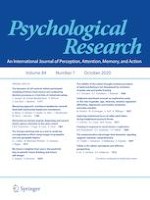10-06-2019 | Original Article
Pointing movements and visuo-spatial working memory in a joint setting: the role of motor inhibition
Gepubliceerd in: Psychological Research | Uitgave 7/2020
Log in om toegang te krijgenAbstract
Previous studies have shown that, under specific conditions, arrays that have been pointed at encoding are recognized better than passively viewed ones. According to one interpretation, the superior recognition of pointed-to arrays can be explained by the motor inhibition of passively viewed arrays. The present study sought to determine whether a similar motor inhibition can be induced also when the participants observed a co-actor perform the pointing movements. Participants were presented with two spatial arrays, one of which was encoded via observation only (the no-move array), while the other was encoded with pointing movements (the move array); movements were performed either by the participant or by the experimenter. Experiment 1 replicated the advantage of self-pointed arrays over passively viewed arrays. Experiment 2 showed that, when participants passively observed the pointing movements performed by the experimenter, move arrays were recognized no better than no-move arrays. Finally, Experiment 3 demonstrated that, in a joint-action condition in which participants alternated with the experimenter in making pointing movements, the advantage of experimenter-pointed arrays over passively viewed arrays was significant and similar in size to the advantage produced by self-performed movements. Importantly, a series of cross-experiment comparisons indicated that the higher recognition of both self- and experimenter-pointed arrays in Experiment 3 could be explained by the motor inhibition of no-move arrays. We propose that, in a joint condition, the pointing movements performed by the experimenter were represented in the same functional way as self-performed movements and that this produced the motor inhibition of passively viewed arrays.
